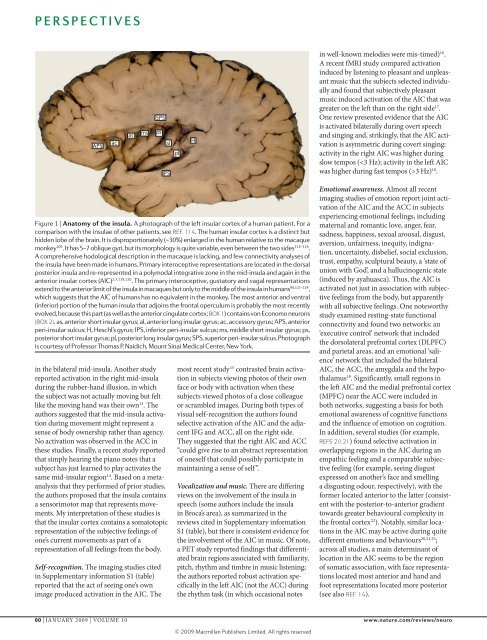How do you feel â now? The anterior insula and human awareness
How do you feel â now? The anterior insula and human awareness
How do you feel â now? The anterior insula and human awareness
Create successful ePaper yourself
Turn your PDF publications into a flip-book with our unique Google optimized e-Paper software.
PersPectivesAPSacasmsSPSpsalIPSplHin wellk<strong>now</strong>n melodies were mistimed) 16 .A recent fMRI study compared activationinduced by listening to pleasant <strong>and</strong> unpleasantmusic that the subjects selected individually<strong>and</strong> found that subjectively pleasantmusic induced activation of the AIC that wasgreater on the left than on the right side 17 .One review presented evidence that the AICis activated bilaterally during overt speech<strong>and</strong> singing <strong>and</strong>, strikingly, that the AIC activationis asymmetric during covert singing:activity in the right AIC was higher duringslow tempos (3 Hz) 18 .Figure 1 | Anatomy of the <strong>insula</strong>. A photograph of the left <strong>insula</strong>r cortex of a <strong>human</strong> patient. For acomparison with the <strong>insula</strong>e of other patients, see ReF. 114. <strong>The</strong> <strong>human</strong> <strong>insula</strong>r cortex is a distinct buthidden lobe of the brain. It is disproportionately (~30%) enlarged in the <strong>human</strong> Nature relative Reviews to | Neurosciencethe macaquemonkey 109 . It has 5–7 oblique gyri, but its morphology is quite variable, even between the two sides 114–118 .A comprehensive ho<strong>do</strong>logical description in the macaque is lacking, <strong>and</strong> few connectivity analyses ofthe <strong>insula</strong> have been made in <strong>human</strong>s. Primary interoceptive representations are located in the <strong>do</strong>rsalposterior <strong>insula</strong> <strong>and</strong> re-represented in a polymodal integrative zone in the mid-<strong>insula</strong> <strong>and</strong> again in the<strong>anterior</strong> <strong>insula</strong>r cortex (AIC) 2,7,119,120 . <strong>The</strong> primary interoceptive, gustatory <strong>and</strong> vagal representationsextend to the <strong>anterior</strong> limit of the <strong>insula</strong> in macaques but only to the middle of the <strong>insula</strong> in <strong>human</strong>s 98,121–124 ,which suggests that the AIC of <strong>human</strong>s has no equivalent in the monkey. <strong>The</strong> most <strong>anterior</strong> <strong>and</strong> ventral(inferior) portion of the <strong>human</strong> <strong>insula</strong> that adjoins the frontal operculum is probably the most recentlyevolved, because this part (as well as the <strong>anterior</strong> cingulate cortex; BOX 1) contains von Economo neurons(BOX 2). as, <strong>anterior</strong> short <strong>insula</strong>r gyrus; al, <strong>anterior</strong> long <strong>insula</strong>r gyrus; ac, accessory gyrus; APs, <strong>anterior</strong>peri-<strong>insula</strong>r sulcus; H, Heschl’s gyrus; IPs, inferior peri-<strong>insula</strong>r sulcus; ms, middle short <strong>insula</strong>r gyrus; ps,posterior short <strong>insula</strong>r gyrus; pl, posterior long <strong>insula</strong>r gyrus; sPs, superior peri-<strong>insula</strong>r sulcus. Photographis courtesy of Professor Thomas P. Naidich, Mount sinai Medical Center, New York.in the bilateral mid<strong>insula</strong>. Another studyreported activation in the right mid<strong>insula</strong>during the rubberh<strong>and</strong> illusion, in whichthe subject was not actually moving but feltlike the moving h<strong>and</strong> was their own 13 . <strong>The</strong>authors suggested that the mid<strong>insula</strong> activationduring movement might represent asense of body ownership rather than agency.No activation was observed in the ACC inthese studies. Finally, a recent study reportedthat simply hearing the piano notes that asubject has just learned to play activates thesame mid<strong>insula</strong>r region 14 . Based on a metaanalysisthat they performed of prior studies,the authors proposed that the <strong>insula</strong> containsa sensorimotor map that represents movements.My interpretation of these studies isthat the <strong>insula</strong>r cortex contains a somatotopicrepresentation of the subjective <strong>feel</strong>ings ofone’s current movements as part of arepresentation of all <strong>feel</strong>ings from the body.Self-recognition. <strong>The</strong> imaging studies citedin Supplementary information S1 (table)reported that the act of seeing one’s ownimage produced activation in the AIC. <strong>The</strong>most recent study 15 contrasted brain activationin subjects viewing photos of their ownface or body with activation when thesesubjects viewed photos of a close colleagueor scrambled images. During both types ofvisual selfrecognition the authors foundselective activation of the AIC <strong>and</strong> the adjacentIFG <strong>and</strong> ACC, all on the right side.<strong>The</strong>y suggested that the right AIC <strong>and</strong> ACC“could give rise to an abstract representationof oneself that could possibly participate inmaintaining a sense of self ”.Vocalization <strong>and</strong> music. <strong>The</strong>re are differingviews on the involvement of the <strong>insula</strong> inspeech (some authors include the <strong>insula</strong>in Broca’s area), as summarized in thereviews cited in Supplementary informationS1 (table), but there is consistent evidence forthe involvement of the AIC in music. Of note,a PET study reported findings that differentiatedbrain regions associated with familiarity,pitch, rhythm <strong>and</strong> timbre in music listening;the authors reported robust activation specificallyin the left AIC (not the ACC) duringthe rhythm task (in which occasional notesEmotional <strong>awareness</strong>. Almost all recentimaging studies of emotion report joint activationof the AIC <strong>and</strong> the ACC in subjectsexperiencing emotional <strong>feel</strong>ings, includingmaternal <strong>and</strong> romantic love, anger, fear,sadness, happiness, sexual arousal, disgust,aversion, unfairness, inequity, indignation,uncertainty, disbelief, social exclusion,trust, empathy, sculptural beauty, a ‘state ofunion with God’, <strong>and</strong> a hallucinogenic state(induced by ayahuasca). Thus, the AIC isactivated not just in association with subjective<strong>feel</strong>ings from the body, but apparentlywith all subjective <strong>feel</strong>ings. One noteworthystudy examined restingstate functionalconnectivity <strong>and</strong> found two networks: an‘executive control’ network that includedthe <strong>do</strong>rsolateral prefrontal cortex (DLPFC)<strong>and</strong> parietal areas, <strong>and</strong> an emotional ‘salience’network that included the bilateralAIC, the ACC, the amygdala <strong>and</strong> the hypothalamus19 . Significantly, small regions inthe left AIC <strong>and</strong> the medial prefrontal cortex(MPFC) near the ACC were included inboth networks, suggesting a basis for bothemotional <strong>awareness</strong> of cognitive functions<strong>and</strong> the influence of emotion on cognition.In addition, several studies (for example,ReFs 20,21) found selective activation inoverlapping regions in the AIC during anempathic <strong>feel</strong>ing <strong>and</strong> a comparable subjective<strong>feel</strong>ing (for example, seeing disgustexpressed on another’s face <strong>and</strong> smellinga disgusting o<strong>do</strong>ur, respectively), with theformer located <strong>anterior</strong> to the latter (consistentwith the posteriorto<strong>anterior</strong> gradienttowards greater behavioural complexity inthe frontal cortex 22 ). Notably, similar locationsin the AIC may be active during quitedifferent emotions <strong>and</strong> behaviours 20,21,23 ;across all studies, a main determinant oflocation in the AIC seems to be the regionof somatic association, with face representationslocated most <strong>anterior</strong> <strong>and</strong> h<strong>and</strong> <strong>and</strong>foot representations located more posterior(see also ReF. 14).60 | JANuARy 2009 | VOLuME 10 www.nature.com/reviews/neuro© 2009 Macmillan Publishers Limited. All rights reserved











